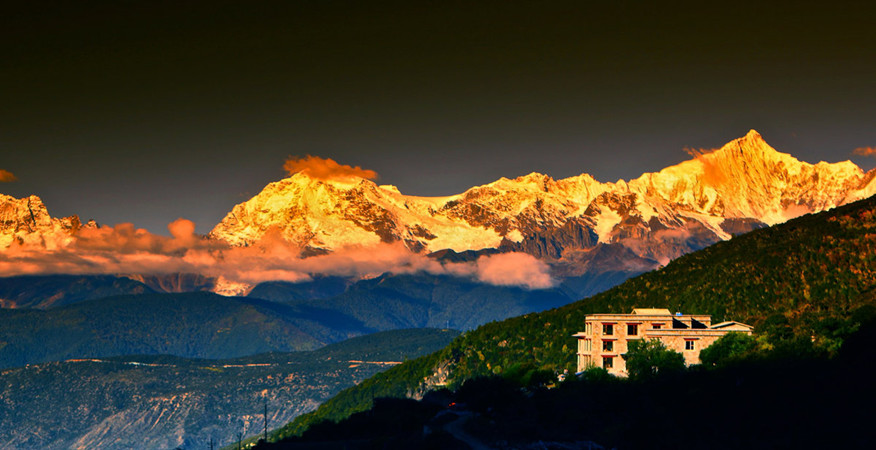
Tibet Travel Permits for Outer Pilgrimage of Meili Snow Mountain
The Outer Pilgrimage of Meili Snow Mountain is a deeply spiritual and physically demanding journey across both Yunnan Province and the Tibet Autonomous Region (TAR). The route passes through several sacred and scenic locations, making it an unforgettable experience for those seeking both physical challenge and spiritual fulfillment.
Key Locations Along the Pilgrimage Route
1. Deqin (德钦) – Starting Point
- Deqin is the gateway to Meili Snow Mountain, located in Yunnan Province. It serves as the starting point of the pilgrimage.
- Altitude: Approximately 3,400 meters above sea level.
- The town offers stunning views of Meili Snow Mountain, one of the most sacred peaks in Tibetan Buddhism.
2. Chawalong Township (察瓦龙乡)
- Located in the Tibet Autonomous Region, Chawalong Township is an important stop along the pilgrimage route.
- Known for its Tibetan Buddhist culture, Chawalong serves as a significant location for circumambulation and spiritual reflection.
3. Shuola Mountain Pass (说拉山口)
- The Shuola Mountain Pass sits at a high altitude and is one of the most important geographical and spiritual locations on the route.
- Altitude: Above 4,000 meters.
- Pilgrims often pause here to perform prayers and circumambulation before continuing their journey.
4. Meili Water (梅里水)
- Meili Water lies at the base of Meili Snow Mountain and is a beautiful area surrounded by stunning natural landscapes.
- It’s a sacred site, with many pilgrims stopping to visit the local Tibetan monasteries before resuming their journey.
5. Return to Deqin
- After completing the circuit, pilgrims return to Deqin, the starting point, having completed their pilgrimage.

Physical and Spiritual Challenges
The Outer Pilgrimage of Meili Snow Mountain is a test of both physical endurance and spiritual devotion.
Altitude and Trekking
- Pilgrims will trek at altitudes above 4,000 meters, where the risk of altitude sickness is significant. Proper acclimatization is necessary to avoid health issues.
- The terrain is rugged and challenging, with steep ascents and uneven paths. This demands physical strength and stamina.
Spiritual Journey
- The pilgrimage is not just about physical endurance; it’s also a spiritual journey. Pilgrims perform kora (circumambulation) around sacred sites, engaging in prayer rituals and reflecting on their spiritual path.
- Each day’s trek is a personal journey of dedication, purification, and devotion.
Time Required
- The journey takes approximately 7.5 days, with 6-8 hours of walking each day and covering over 150 kilometers in total.
- It’s important to be well-prepared for the demanding nature of this trek.
Essential Preparations for the Outer Pilgrimage
1. Physical Preparation and Health Considerations
- Acclimatization: Ensure proper acclimatization before starting the trek to avoid altitude sickness. Spending a few days at lower altitudes before heading into the higher regions is crucial.
- Medical Supplies: Bring necessary medications for altitude sickness, as well as general first aid supplies.
- Fitness: It’s recommended to train for the physical demands of this trek, particularly for long hiking days and high-altitude walking.
2. Necessary Gear and Equipment
- Footwear: Sturdy hiking boots are a must for the rough terrain, along with woolen socks to keep feet warm.
- Clothing: Bring layered clothing for cold weather conditions, including thermal layers, waterproof jackets, and gloves.
- Backpack: A durable backpack to carry necessary supplies for the trek, including food, water, and clothing.
- Sleeping Bags: A high-quality sleeping bag that is suitable for high-altitude conditions.
3. Booking the Pilgrimage with a Licensed Travel Agency
- Choosing the Right Agency: You must book your pilgrimage through a licensed travel agency that specializes in Tibet tours. They will take care of logistics, including Tibet Travel Permits, permits for restricted areas, and provide local guides.
- Group Travel: Solo travel in Tibet is generally prohibited, so you’ll need to join a group tour organized by the agency.
Additional Permits for Restricted Areas
While much of the pilgrimage route lies within Yunnan Province, certain areas in Tibet require additional permits.
Alien’s Travel Permit
- Required for foreign travelers visiting restricted or border areas within Tibet. Your travel agency will arrange this permit on your behalf.
Military Permit
- This permit may be required for areas near the Tibet-India border or other sensitive regions. The travel agency will help obtain this if necessary.
Best Time to Undertake the Outer Pilgrimage
Seasonal Considerations
- The best time to undertake the Outer Pilgrimage is during spring (March-May) and autumn (September-November) when the weather is stable, and the temperatures are milder.
- Winter (December-February) is extremely cold, and summer (June-August) may bring unpredictable rains, making the terrain slippery and more difficult.
Traveling Responsibly
Respect Local Culture
- Tibet has a rich spiritual and cultural heritage. Be sure to respect local Tibetan Buddhist customs. Always ask for permission before taking photographs, especially in religious sites.
Environmental Impact
- The Meili Snow Mountain region is a pristine wilderness, so it’s important to minimize your environmental impact. Pack out all trash, avoid disturbing wildlife, and respect the natural beauty of the area.
A Journey of a Lifetime
The Outer Pilgrimage of Meili Snow Mountain is a physically demanding yet spiritually enriching journey. By properly preparing, securing the necessary Tibet Travel Permits, and booking your trip through a licensed travel agency, you can ensure a safe and fulfilling experience. This pilgrimage offers not only a physical challenge but also a profound spiritual connection to one of Tibet’s most revered mountain ranges.
















